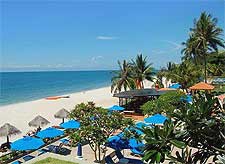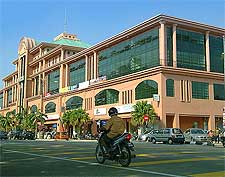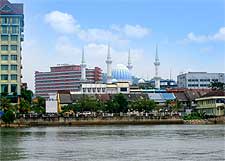Kuantan History Facts and Timeline
(Kuantan, Pahang, Malaysia)

Mentioned in the first century as an outpost of the Chih Tu Empire, established by peoples from modern-day
China,
Vietnam and
India, Kuantan's coastal location meant it has fallen to a succession of colonial invaders during the past 2,000 years in its history.
Next came the small Phen Keng Empire in the 11th century, followed by the Siamese in the 12th century, but it wasn't until the 1850s that Kuantan really put itself on the map. The cemetery on the Taman Esplanade bears witness to the small fishing community that developed here at the mouth of the Teruntum River during this time, just in front of the hospital that stands here today.
Industrial Kuantan
Like many parts of the region, Kuantan was dominated by its relationship with China prior to European settlement. By the late 19th century, miners from the Chinese mainland made their way to the area to tap into the rich mineral deposits here, establishing a thriving community as trade flourished. Tin was mined in the nearby towns of both Sungai Lembing and Gambang.

History of the British Period
The commercial value of Kuantan and the surrounding area was not lost on the British, who by the early 20th century, had added the state of Pahang to their growing list of Malay concessions under the East India Company.
During this period, the colonialists also established the area's first rubber plantations, now a common site around Kuantan, bringing in Indians as manual labourers. Buildings from this era can still be seen in the city today, including remnants of British forts built to defend the surrounding area.

Kuantan at War
Like many towns and cities within the sprawling British Empire, Kuantan fell to the Japanese during World War II and the area turned into a battlefield. The HMS Repulse was sunk off the coast here in December 1941, along with the HMS Prince of Wales, in the Naval Battle of Malaya. Their wrecks were found upside down in the waters off Kuantan following the end of the war and, in 2002, the bell was removed from the Prince of Wales and now hangs in the Merseyside Maritime Museum in Liverpool.

State Capital
Shortly before the British left Malaysia, Kuantan took over as the state capital of Pahang from Kuala Lipis in 1955. Where mining and then rubber had boosted the city's commercial appeal, the introduction of federal government prompted further growth and this continued after independence.
The most recent chapter in the history of Kuantan has been marked by a plethora of development projects. Also, with the area recently becoming the very first Special Economy Zone (SEZ) of Malaysia, the economy of this region is set to further enhance, increasing tourism and prosperity.
 Mentioned in the first century as an outpost of the Chih Tu Empire, established by peoples from modern-day China, Vietnam and India, Kuantan's coastal location meant it has fallen to a succession of colonial invaders during the past 2,000 years in its history.
Mentioned in the first century as an outpost of the Chih Tu Empire, established by peoples from modern-day China, Vietnam and India, Kuantan's coastal location meant it has fallen to a succession of colonial invaders during the past 2,000 years in its history.

